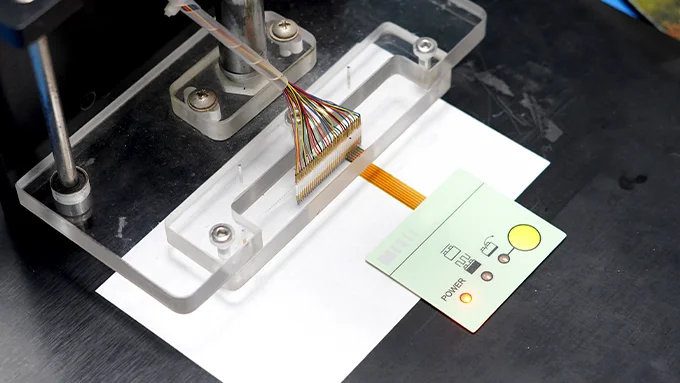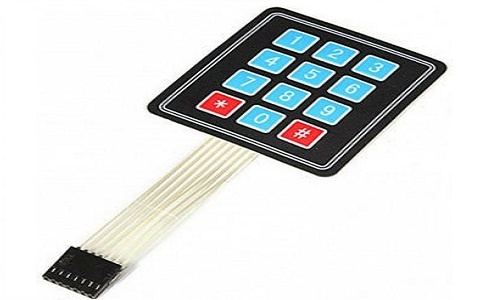The Manufacturing Refine Behind Membrane Layer Switch: What You Need to Know
The production procedure behind membrane layer switches over combines cautious design, material choice, and high quality control. It begins with recognizing the details of membrane switch style and progresses with different phases, consisting of material choices and printing methods. Each phase plays a vital function in making sure performance and longevity. However, the complexities of layer building and construction and the extensive testing standards might reveal understandings that are not promptly apparent. What lies beyond these fundamental aspects?
Recognizing Membrane Change Design
Although membrane layer buttons may appear simple initially glimpse, their layout entails detailed factors to consider that ensure functionality and resilience. The style procedure starts with a detailed understanding of user needs, consisting of the user interface's designated application and environmental variables. Functional designs is a key component, as the design must promote convenience of usage while guaranteeing that tactile responses meets individual expectations.Moreover, the layering of elements, such as graphic overlays, sticky layers, and conductive traces, need to be specifically engineered. membrane switch. This layered configuration not only influences the switch's responsiveness however likewise influences its longevity. Attention is offered to the securing strategies used to protect against dampness and dust, which could endanger efficiency. Additionally, design considerations encompass aesthetics, where color systems and visual quality boost individual experience. Inevitably, the layout of membrane layer switches over equilibriums functionality, user experience, and durability, guaranteeing that they meet the needs of various applications successfully
Products Used in Membrane Layer Switch Production
When choosing materials for membrane button manufacturing, it is necessary to contemplate both efficiency and longevity. The primary materials include polyester and polycarbonate movies, which supply versatility and toughness. These movies are typically coated with adhesive to assure correct bonding to substrates. Conductive inks, generally composed of silver or carbon, are essential for producing electric connections within the button, permitting for reputable operation.Additionally, a safety layer, such as a tough coat, is regularly used to enhance scrape resistance and longevity. The choice of backing product, such as acrylic or foam, can considerably influence the button's responsive feeling and overall individual experience. Numerous ecological variables, including temperature level and moisture, should lead product selection to assure peak efficiency in particular applications. Eventually, the ideal combination of products contributes to the membrane layer button's performance and life-span, making notified selections important for suppliers.
The Printing Refine: Creating Graphics and Text
The printing process in membrane button production plays a substantial function in creating top notch graphics and text. Different visuals style methods are used to assure visual allure and functionality, while mindful ink selection techniques are necessary for resilience and performance. Recognizing these components is fundamental for accomplishing best outcomes in membrane layer switch layout.
Graphic Style Techniques
Graphic style strategies play a vital duty in the printing procedure of membrane switches, as they define just how graphics and message will ultimately appear on the last product. Effective graphic layout involves the strategic use of formats, colors, and fonts to boost readability and aesthetic allure. Designers often utilize vector graphics for scalability, making certain that pictures continue to be sharp at different dimensions. Additionally, attention to comparison and alignment is essential, as it affects individual interaction and aesthetic top quality. The consolidation of branding components, such as logo designs, need to be managed with like keep brand honesty. Overall, thoughtful graphic layout techniques contribute significantly to the functionality and appearance of membrane switches, impacting user experience and item efficiency.
Ink Choice Methods
Picking the suitable ink is crucial for achieving the desired visual quality and durability in membrane switch production. Numerous ink kinds are utilized, including solvent-based, water-based, and UV-curable inks. Each type uses distinct attributes, such as resistance, flexibility, and attachment to ecological elements. Solvent-based inks are often favored for their toughness and vibrant colors, while water-based inks are more environmentally friendly but may have limitations in bond. UV-curable inks offer rapid curing and durable performance. Additionally, color matching techniques assure that the selected inks straighten with layout requirements. Inevitably, the selection of ink should take into consideration variables such as application method, substratum compatibility, and end-use needs to accomplish premium lead to membrane layer switch graphics and text.
Layer Building And Construction and Assembly

Product Option Refine
A cautious choice of materials is crucial in the manufacturing procedure of membrane layer buttons, as it straight influences functionality and resilience. The main products utilized consist of polyester, polycarbonate, and different conductive inks. Polyester is commonly preferred for its exceptional resistance to chemicals and abrasion, making it appropriate for harsh settings. Polycarbonate, on the various other hand, supplies superior quality and impact resistance, which is valuable for applications needing exposure and effectiveness. Conductive inks, normally made up of silver or carbon, are essential for developing reputable electric paths. In addition, the option of sticky materials affects the total discover here integrity of the switch - membrane switch. Examining elements such as ecological exposure, tactile feedback, and visual requirements guides manufacturers in selecting the very best materials for their specific applications
Layer Attachment Methods
Adhering layers in membrane layer button building is a vital process that guarantees performance and longevity. Various bond methods are utilized to protect excellent bonding in between layers, which generally include using adhesives, heat, and stress. Pressure-sensitive adhesives (PSAs) are generally utilized for their simplicity of application and instant bonding capacities. Additionally, thermal bonding methods can be used, where heat is made use of to trigger sticky homes, protecting a solid bond. The selection of adhesion technique greatly depends upon the materials entailed and the particular application requirements of the membrane layer button. Appropriate placement and uniform application of adhesives are necessary to stop defects, securing the button operates effectively throughout its intended life expectancy.
Quality Assurance Actions
Ensuring quality assurance throughout the layer construction and assembly of membrane layer switches is crucial for maintaining performance and dependability. This process generally includes a number of vital procedures, including comprehensive evaluations at each stage of manufacturing. Manufacturers utilize innovative screening techniques, such as peel examinations and adhesion evaluations, to verify the stability of layer bonds. Additionally, aesthetic evaluations are carried out to recognize any type of issues in printing or product disparities. Ecological problems, such as temperature level and humidity, are very carefully kept track of to ensure perfect healing and attachment. Furthermore, regular calibration of devices aids maintain specific manufacturing requirements. By carrying out these top quality control steps, makers can significantly minimize the risk of item failure, guaranteeing that the final membrane switches over satisfy the required specs and customer expectations.
Checking and Quality Assurance Procedures

Advancements in Membrane Change Modern Technology
As innovations in innovation continue to progress, membrane switches are taking advantage of cutting-edge growths that improve their functionality and user experience. One notable innovation is the assimilation of capacitive touch technology, which permits even more responsive and intuitive interface. This shift not just boosts looks yet also reduces mechanical damage, extending the life expectancy of the switches.Additionally, improvements in visuals overlay products have brought about improved longevity and resistance to environmental factors such as moisture and UV light. These materials now provide improved quality and brightness, further raising the visual appeal.Furthermore, the incorporation of smart innovation is changing membrane layer switches into interactive control panels, allowing connection with IoT devices. This connectivity cultivates a smooth individual experience, leading the way for applications in numerous industries, from medical care to consumer electronics. Jointly, these innovations click to read placement membrane layer switches as vital elements in modern gadget style.
Regularly Asked Inquiries
For how long Does the Membrane Switch Over Manufacturing Refine Take?
The duration of the membrane button production procedure can vary significantly. Variables such as intricacy, products used, and production quantity influence timelines, with common production ranging from a few days to numerous weeks for completion.
What Are the Common Applications for Membrane Switches?
Membrane buttons are typically used in numerous industries, consisting of automotive controls, home home appliances, clinical gadgets, and customer electronics (membrane switch). Their flexibility and resilience make them ideal for applications requiring easy to use interfaces and reliable efficiency in varied settings
Can Membrane Switches Over Be Personalized for Specific Needs?

What Is the Life-span of a Typical Membrane Layer Change?
The life-span of a regular membrane button differs, but normally, it ranges from 1 to 5 million cycles. Variables such as usage, environment, and worldly quality significantly influence durability and general efficiency with time.

Are Membrane Layer Changes Eco-friendly?
The environmental kindness of membrane changes varies. Some materials made use of might not be recyclable, while others can be green. The general effect depends upon producing methods and products, requiring careful factor to consider throughout choice and disposal. The manufacturing process behind membrane switches combines mindful style, material choice, and top quality control. It starts with recognizing the complexities of membrane switch layout and proceeds with different stages, including product choices and printing methods. When picking products for membrane button production, it is essential to ponder both performance and longevity. A careful option of materials is important in the production procedure of membrane buttons, as it straight affects performance and toughness. The selection of adhesion technique mainly depends on the products included and the details application demands of the membrane button.